Testing Furuno DRS4D-NXT solid-state Doppler radome, “Radar Redefined” most definitely
After many hours testing a NXT radome on Gizmo in often busy Maine waters, I believe that Furuno’s bold “Radar Redefined” claim is completely justified. This radar is so smart that it makes sense to run it in broad daylight. Brightly highlighting the one vessel (above) moving toward me in Camden Harbor’s forest of moored and moving boats is just one example of its highly automated and intelligent features. I fear that many readers will suffer radar jealousy as I detail what I’ve seen so far, but let’s look at the bright side and honor Furuno for setting a significantly new performance bar that other major manufacturers will hopefully try hard to attain…
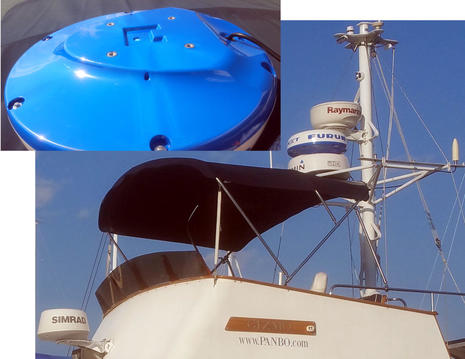 First, let’s consider the hardware involved. The Furuno DRS4D-NXT is a 24-inch radome (with an unusually low 8.7 inch height) that works with NavNet TZT and TZT2 multifunction displays. I’m testing it with a 12-inch TZT2, specifically known as a NavNet TZTL12F. The TZT2 hardware and software are quite different from the TZT, and while Fred Khedouri nicely shared his first impressions here last summer, I plan to add my two cents in a future entry. I will, however, point out aspects of the new TZT2 interface that add to the NXT’s easy-to-use high performance.
First, let’s consider the hardware involved. The Furuno DRS4D-NXT is a 24-inch radome (with an unusually low 8.7 inch height) that works with NavNet TZT and TZT2 multifunction displays. I’m testing it with a 12-inch TZT2, specifically known as a NavNet TZTL12F. The TZT2 hardware and software are quite different from the TZT, and while Fred Khedouri nicely shared his first impressions here last summer, I plan to add my two cents in a future entry. I will, however, point out aspects of the new TZT2 interface that add to the NXT’s easy-to-use high performance.
Installation is simple, too. Up on the mast a pigtail coming out of the radome plugs into a combined Ethernet and 12v power cable which splits at the helm end, Ethernet plugging into the TZT2 (or a Furuno network), while the 12v wires only need a 2.5 amp supply as NXT is a solid-state radar using semiconductors to transceive pulses instead of a traditional magnetron. That also means that the NXT goes into standby and transmit modes very quickly and does not emit dangerously high power microwaves.
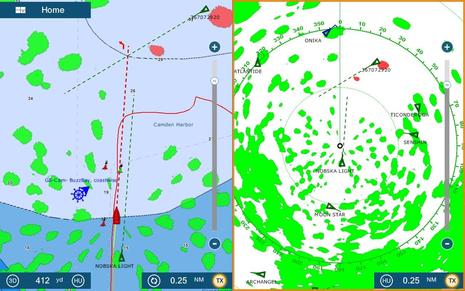 While it’s great that Furuno (plus Garmin and Raymarine) joined the Navico brands with solid-state radar this year, I got especially excited about the Doppler radar target speed feature that Furuno (and Garmin) demonstrated at the Miami Boat Show. Well, Camden outer harbor can be an even more challenging target environment and the NXT Target Analyzer feature has consistently nailed it. All those green blobs are boats (some several boats), and a few of the ones up ahead of Gizmo are moving away or quite slowly. Similarly, the AIS target (and handsome trawler) Nobska Light behind Gizmo is not highlighted because it’s not overtaking at more than 3 knots. What are highlighted, however, are two boats that really were of concern, neither of which was particularly obvious even in broad daylight.
While it’s great that Furuno (plus Garmin and Raymarine) joined the Navico brands with solid-state radar this year, I got especially excited about the Doppler radar target speed feature that Furuno (and Garmin) demonstrated at the Miami Boat Show. Well, Camden outer harbor can be an even more challenging target environment and the NXT Target Analyzer feature has consistently nailed it. All those green blobs are boats (some several boats), and a few of the ones up ahead of Gizmo are moving away or quite slowly. Similarly, the AIS target (and handsome trawler) Nobska Light behind Gizmo is not highlighted because it’s not overtaking at more than 3 knots. What are highlighted, however, are two boats that really were of concern, neither of which was particularly obvious even in broad daylight.
Now you may be thinking that the NXT targeting looks a little rough, and that deserves discussion. For one thing, the right hand radar window is set at 0.25 nm range and slightly zoomed in, while the same range is showing on the much more zoomed in chart overlay window. I could, for instance, tap that Refresh button (near Nobska Light on the overlay) and the radar would instantly range down to a more zoom appropriate and better resolved 0.125 or 0.0625 nm range. I also could have put the NXT into truer color mode with RezBoost beam sharpening to maximize the target detail. But radar target detail becomes much less important once you’re confident that the Doppler aids really work, and Target Analyzer’s red highlights are just the beginning of what NXT does with Doppler.
“Auto Acquire by Doppler” is found in the TZT2’s Home/Settings/Radar menu and in my experience it’s so good that it ought to be On by default. Furuno has long been the only company to offer ARPA, not MARPA, on recreational radars. Not surprisingly, Automatic Radar Plotting Aid means that the radar can automatically lock onto targets and determine their course and speed, as well as the Closest Point of Approach (CPA) and Time of CPA (TCPA) that you and that vessel will experience as long as both maintain course and speed. Mini ARPA (MARPA) would be better named Manual ARPA because you have to select each radar target to acquire (though touchscreens have made that easier).
At any rate, my testing indicates that Furuno has substantially outdone its own unique self; NXT’s Doppler assisted ARPA is fast, accurate, and darn smart. While it was impressive that the 19-inch DRS2D I tested could do ARPA at all, it had to be set up in a Guard Zone and it sometimes tracked nav aids and ledges as well as moving boats. NXT ARPA just works, rarely makes mistakes, and I find myself using it all the time, as you’ll see on many of the following screens. Furuno, incidentally, calls this new level of ARPA “Fast Target Tracking,” and again I believe that’s justified.
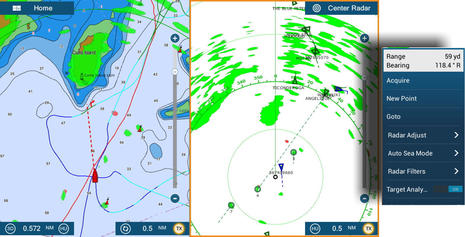 Here I’ve headed back into Camden Harbor’s main entrance while the NXT is making Doppler assisted decisions about which targets to track. Obviously, they’re not just the ones that Target Analyzer highlights, as the single fully red target hasn’t even been selected yet (it was a very fast outboard as I recall, and it did get quickly tracked shortly thereafter). The NXT also hadn’t yet tracked the AIS equipped vessel Gizmo is leaving to starboard, but it was a daysailer nearly stopped as it set sail. But note target #4, which was coming in fast on Gizmo’s port quarter and which Target Analyzer is just starting to paint red as it turned more toward Gizmo’s path.
Here I’ve headed back into Camden Harbor’s main entrance while the NXT is making Doppler assisted decisions about which targets to track. Obviously, they’re not just the ones that Target Analyzer highlights, as the single fully red target hasn’t even been selected yet (it was a very fast outboard as I recall, and it did get quickly tracked shortly thereafter). The NXT also hadn’t yet tracked the AIS equipped vessel Gizmo is leaving to starboard, but it was a daysailer nearly stopped as it set sail. But note target #4, which was coming in fast on Gizmo’s port quarter and which Target Analyzer is just starting to paint red as it turned more toward Gizmo’s path.
Frankly, I don’t know the exact logic to NXT’s Doppler ARPA acquisition — the brochure simply says “any vessel approaching yours will automatically display a target vector” — but in the last 10 days it has often been my first warning of incoming targets that I could have seen myself, and I think I have a pretty good sea eye. Added to the image above is the menu you get by tapping on the radar screen. You can manually acquire a target if Doppler hasn’t done the job already, and the target is usually resolved very quickly and accurately (probably with Doppler help). This is also where you can turn Target Analyzer on or off…
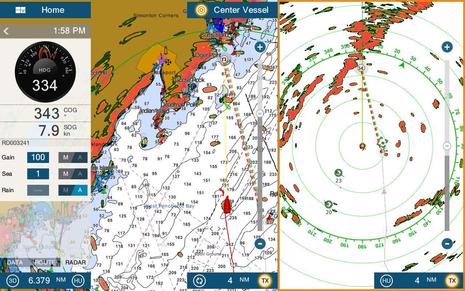 …and, dang, how nice it was to realize that the automatic Doppler target acquisition works even when Target Analyzer is not in use. This screen also shows how you can left swipe the TZT2 screen to get the Data Box with its Radar control tab. Here or from the Radar screen tap menu above — there are often multiple ways to access controls on the TZT2 — you can manually control radar gain as well as sea and rain clutter. But so far the auto modes have worked very well for me (and in Target Analyzer mode, they are all auto).
…and, dang, how nice it was to realize that the automatic Doppler target acquisition works even when Target Analyzer is not in use. This screen also shows how you can left swipe the TZT2 screen to get the Data Box with its Radar control tab. Here or from the Radar screen tap menu above — there are often multiple ways to access controls on the TZT2 — you can manually control radar gain as well as sea and rain clutter. But so far the auto modes have worked very well for me (and in Target Analyzer mode, they are all auto).
In this scene I’ve been loosely following a route up the Bay and those ARPA targets behind me were meaningful. The fact that the NXT has decided to track blob #25 strongly indicates that it is meaningful. Incidentally, NXT ARPA targets seems to work pretty much regardless of range settings. I can range in tight for minutes at a time and when I range out again, distant targets are still there and accurate. Wow.
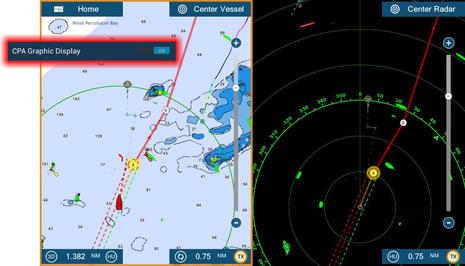 And that’s not all. The NXT and TZT2 can also display a graphic Closest Point of Approach (CPA). If you click the screen above larger, you’ll see that Gizmo will soon pass ARPA target #7 port-to-port and that the two connected “+” signs show when, where, and how the CPA will take place. I find this graphic much more informative than the numeric CPA and TCPA I could have gotten by tapping target #7, and that’s especially true in a crossing situation when a CPA of, say. 0.1 nm does not tell if that’s in front of or behind the vessel you’re crossing.
And that’s not all. The NXT and TZT2 can also display a graphic Closest Point of Approach (CPA). If you click the screen above larger, you’ll see that Gizmo will soon pass ARPA target #7 port-to-port and that the two connected “+” signs show when, where, and how the CPA will take place. I find this graphic much more informative than the numeric CPA and TCPA I could have gotten by tapping target #7, and that’s especially true in a crossing situation when a CPA of, say. 0.1 nm does not tell if that’s in front of or behind the vessel you’re crossing.
 You may notice how my radar and chart overlay windows differ in terms of ARPA and AIS display. Those and many other data layers are easily controlled with the Layer menus you get by swiping up from the bottom of a TZT2 screen. The image above shows what I get when the swipe is done on the Radar window side with Chart Layer collaged above. This is an easy, powerful interface and I’m finding that I like different Layer mixes in different target density conditions. Note that full Active Captain info is available on the charts, and that these menus can be invoked in other ways including the new MCU004 Remote Control I’m also testing.
You may notice how my radar and chart overlay windows differ in terms of ARPA and AIS display. Those and many other data layers are easily controlled with the Layer menus you get by swiping up from the bottom of a TZT2 screen. The image above shows what I get when the swipe is done on the Radar window side with Chart Layer collaged above. This is an easy, powerful interface and I’m finding that I like different Layer mixes in different target density conditions. Note that full Active Captain info is available on the charts, and that these menus can be invoked in other ways including the new MCU004 Remote Control I’m also testing.
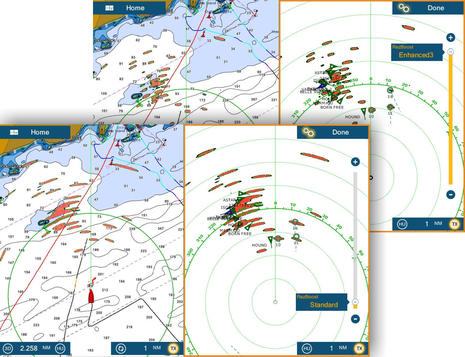 Here is a fairly extreme example of the DRS4D-NXT RezBoost beam sharpening feature at work on the TZT2. In the foreground, RezBoost is in “Standard” mode which seems to be essentially off as the targets are blobbed together and elongated in the way typical of a 24-inch radome with a 3.9 degree horizontal beam width. But with RezBoost at maximum Enhanced3, the gaggle of sailboats waiting for wind to start a race are better defined (as is the Heading error that shows on nav aids and in some of these screen shots). Furuno claims that RezBoost can effectively emulate a 2 degree beam width, and that seems true (as it is with other solid-state radars like the pioneering Simrad Broadband 4G).
Here is a fairly extreme example of the DRS4D-NXT RezBoost beam sharpening feature at work on the TZT2. In the foreground, RezBoost is in “Standard” mode which seems to be essentially off as the targets are blobbed together and elongated in the way typical of a 24-inch radome with a 3.9 degree horizontal beam width. But with RezBoost at maximum Enhanced3, the gaggle of sailboats waiting for wind to start a race are better defined (as is the Heading error that shows on nav aids and in some of these screen shots). Furuno claims that RezBoost can effectively emulate a 2 degree beam width, and that seems true (as it is with other solid-state radars like the pioneering Simrad Broadband 4G).
But again, target detail becomes a lot less important if you’re confident that Doppler features will quickly highlight incoming vessels. And while I’ve seen excellent NXT performance, all the testing so far has been in quite calm and clear conditions. If that race had ever started, for instance, I might have captured some memorable target screens. I also look forward to getting out in rain cells — Target Analyzer has a mode for that — and there will be a series of radome comparisons.
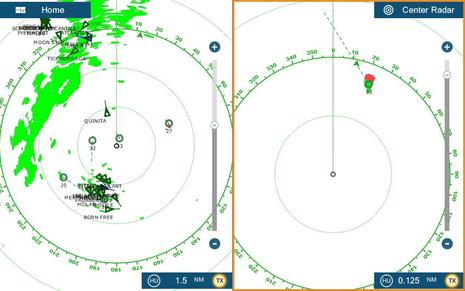 The NXT also has a dual range mode, though it’s limited to 12 nm range max and the NXT’s antenna rotation stays at 24 RPM. Yes, in normal single-range mode, the NXT automatically chooses 24/36/48 rotation speeds, and those higher speeds must help the Doppler with the amazingly accurate tracking of fast, close targets.
The NXT also has a dual range mode, though it’s limited to 12 nm range max and the NXT’s antenna rotation stays at 24 RPM. Yes, in normal single-range mode, the NXT automatically chooses 24/36/48 rotation speeds, and those higher speeds must help the Doppler with the amazingly accurate tracking of fast, close targets.
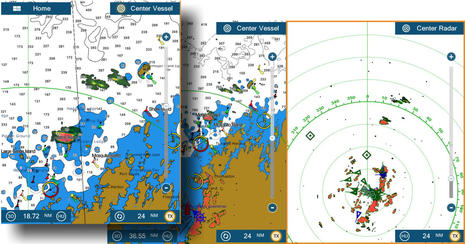 The DRS4D-NXT may not have the range of Furuno’s similar size magnetron radars, but it’s not bad. On the screens above, NXT is imaging Matinic Island at 17 nm and Monhegan (I think) at about 26. Click the collage bigger to see how I was able to pinch zoom and drag the chart overlay window to better see what was going on out there. The TZT2 is smooth and quick at screen manipulations like this, and it’s dead simple to return to normal operations with on touchscreen control buttons like Center Vessel, Reset Range, Head Up / North Up, and more.
The DRS4D-NXT may not have the range of Furuno’s similar size magnetron radars, but it’s not bad. On the screens above, NXT is imaging Matinic Island at 17 nm and Monhegan (I think) at about 26. Click the collage bigger to see how I was able to pinch zoom and drag the chart overlay window to better see what was going on out there. The TZT2 is smooth and quick at screen manipulations like this, and it’s dead simple to return to normal operations with on touchscreen control buttons like Center Vessel, Reset Range, Head Up / North Up, and more.
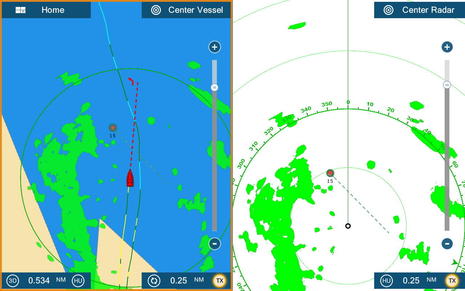 I have seen a possible bug or two, which is not surprising with a brand new radar technology and quite young MFD software. The worst was Sunday evening on the third leg of a fabulous Maine mini cruise. TZT2 and NXT were a great help getting to a granite island hike in the morning and then to a fancy lunch and live Shakespeare in Stonington, but when fired up for a sunset crossing to North Haven, there was no chart detail. There was also no way to change to raster charts (as seen in the Layer menu above), even after a total reboot. So that’s only a crude Mapmedia base map seen on the chart window above, but — holy cow — that Target Analyzer hot blob and ARPA target #15 was a kayak and it was coming out from behind a high ledge and large nav aid
I have seen a possible bug or two, which is not surprising with a brand new radar technology and quite young MFD software. The worst was Sunday evening on the third leg of a fabulous Maine mini cruise. TZT2 and NXT were a great help getting to a granite island hike in the morning and then to a fancy lunch and live Shakespeare in Stonington, but when fired up for a sunset crossing to North Haven, there was no chart detail. There was also no way to change to raster charts (as seen in the Layer menu above), even after a total reboot. So that’s only a crude Mapmedia base map seen on the chart window above, but — holy cow — that Target Analyzer hot blob and ARPA target #15 was a kayak and it was coming out from behind a high ledge and large nav aid
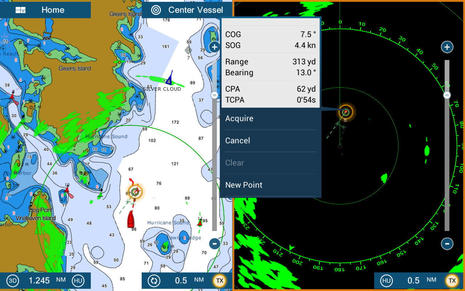 Yesterday morning the TZT2’s included NOAA-based vector and raster charts worked just fine again, and I’ll conclude with two more NXT Doppler screens. Maybe I’ve gone overboard, but have you ever seen a radome (or any recreational radar) able to automatically highlight and track like this? In the situation above, the sailboat was first shown by Target Analyzer, then detailed by ARPA, and finally the CPA was drawn on screen. I didn’t do anything except tap the ARPA target on the radar window to pop up the numeric details, and note how the same target was then nicely marked on the chart window with an orange circle.
Yesterday morning the TZT2’s included NOAA-based vector and raster charts worked just fine again, and I’ll conclude with two more NXT Doppler screens. Maybe I’ve gone overboard, but have you ever seen a radome (or any recreational radar) able to automatically highlight and track like this? In the situation above, the sailboat was first shown by Target Analyzer, then detailed by ARPA, and finally the CPA was drawn on screen. I didn’t do anything except tap the ARPA target on the radar window to pop up the numeric details, and note how the same target was then nicely marked on the chart window with an orange circle.
A short time later I was ogling and photographing the fascinating SWATH superyacht Silver Cloud when NXT and noise alerted me about an open lobster boat crossing from the starboard danger zone so fast that I only captured the screen below after the fact. That’s what I mean by radar that makes sense to run in broad daylight, and doesn’t it look to be invaluable in fog or darkness? Congratulations to Furuno for the DRS4D-NXT, may the competition take heed, and sorry about the radar jealousy.


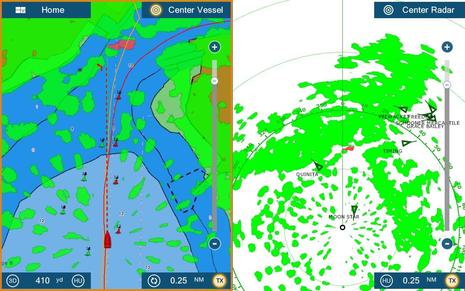
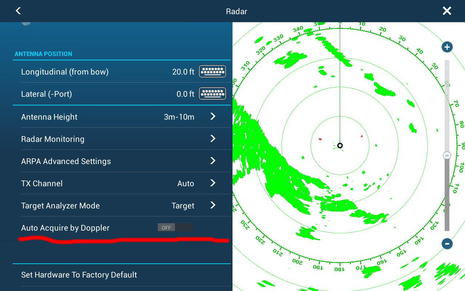
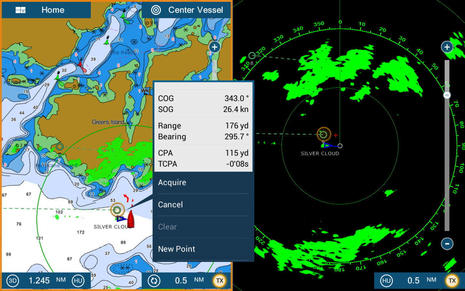
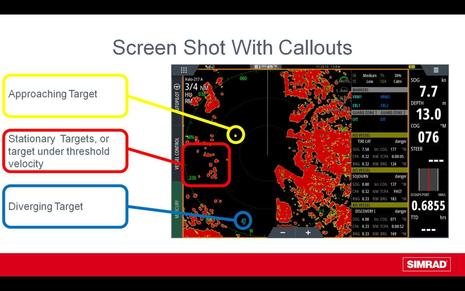

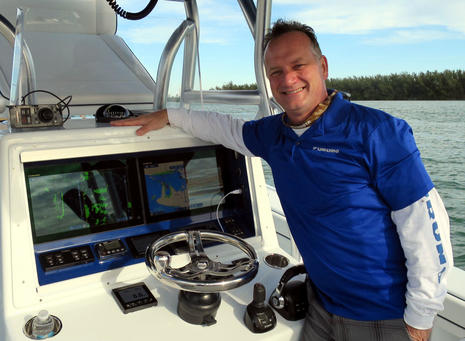
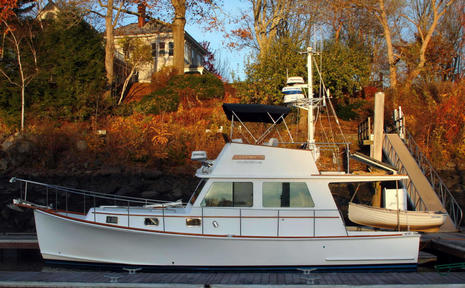







PS: This 2010 entry shows a bit of what Camden Outer Harbor looks like and also shows the odd NOAA presentation of the channel buoys that has never been corrected but has trickled down to all electronic charts:
https://panbo.com/archives/2010/07/camden_noaa_chart_changes_the_questions.html
Also, I’m wondering if Furuno’s ad department is also Doppler assisted, or something. Of course they knew I was testing the NXT radar, but how did they manage to send NXT ads minutes after we published this entry?
Nicely detailed report. With that confidence in the ARPA, it would be tempting to leave it on as you note and rely on alarming…
Hi Ben:
Have they preserved the “true wake” feature? That is what I like best about my older Furuno radar and I would think it would definitely help to differentiate moving from moored boats in that crowded harbor of yours.
I can really feel your excitement, Ben. I’m hoping Furuno would offer a portrait TZ2 version so one could drop it into the slot left by standalone radars. I think quite a few people would jump on the opportunity to install an SS Radar given the Portrait vs. Landscape option.
Cheers
Don
Interesting, Don. I recall that the L in the awkward model name TZTL12F stands for Landscape, so…?
I have not yet checked out echo modes, Bird Mode, and some other features, but will.
Hi Ben!
Interesting article! Is it possible to set the presentation to the following combination in both radar screen and chart screen:
North up
Off center
True Vectors (both own vessel and other targets)
Heading line (“to infinity”)
True trails
A possibility to easy change the vector length and true/relative vectors in the configuration above.
This is the way we professional mariners in Scandinavia like to configure the presentation.
Sven-Bertil Carlsson
Chief officer on a car and passenger ferry
Awesome report and what looks to be a great product. I can’t justify upgrading my conventional 4kw dome, but it sure is tempting. I hope open arrays are not that much farther behind. That would be enough of a performance upgrade to justify. I would probably keep the 4kw dome for redundancy then.
Furuno is selling it outside the USA already
http://www.furuno.com/special/en/radar/drs6ax-class/
Howard, the DRS6AX looks interesting, but it is not a solid-state radar at 6kW peak output power.
I’m a little surprised that Furuno is using the term “Fast Target Tracking” with it because I think the NXT Doppler is what makes FTT amazingly fast to lock in and also smart about which target it tracks. The big DRS6AX also has a 30 target max, whereas NXT can purportedly handle 100 at once (40 automatic and 60 manually chosen, I think).
Sven, I hope to check on “true trails” (and vectors) tomorrow, but think it may be another feature that won’t seem so valuable once you’ve experienced Furuno’s Doppler assisted ARPA.
In the meantime, Head Up and North Up can be changed right on the TZT2 screen, chart and radar independently (but there is no Course Up). You can also drag the center of each screen however you want and it stays there underway until you tap the Center Vessel button. Same with pinch zoom until you hit the Reset Range on the chart side or change ranges on the radar side. I find it all very intuitive and effective.
Interesting, thanks for the write up.
One of the aspects that bothers me about Marpa is the fact that you have to manually mark the target, to get a vector of the boat.
I really like the fact that this Doppler radar radar does this automatically, and is arpa, not Marpa.
Has anyone heard if the Simrad halo will eventually incorporate a version which will provide vectors without manually selecting the target? IE, Arpa, not Marpa. Perhaps through a new halo version or through a software update?
Sdpaddler, I think that all the major brands have wanted to provide ARPA for quite a while, but apparently it’s not easy to do. And now that solid-state Doppler technology has been shown to make ARPA even easier and more effective, I’d guess that the pressure is high.
Simrad, incidentally, was talking about adding Doppler to the Halo radars before NXT or Garmin Fantom came along.
Let’s note, though, that you have to buy a Furuno TZT or TZT2 to use a NXT radar, and while they are fine MFDs, Furuno does not offer some of the options that the other big brands do, like network displays smaller than 12 inches and side imaging.
Sven, I need to double check, but I don’t think that the TZT2 offers any kind of radar trails, let alone true wakes. That doesn’t mean that the solid-state NXT radar can not produce trails — in fact they are shown in the brochure — but I think that so far they’re only available on the TZT screens.
(I believe that TZT2 is a complete rewrite of the Time Zero MFD software because it’s running on Android instead of Windows. So no one should expect to see all the features they may have seen on the original TZT or NavNet 3D, but then again they may get added in future updates. Which, as I have seen, can be fully automatic if you allow.)
I did find a choice of True or Relative Bearings and EBLs in the TZT2’s Radar Menu, and you can easily turn the Radar Heading Line on and off.
Way cool. Second the earlier motion that it would be ever so nice to be able to drop one of these new displays into the hole left by its predecessor (e.g., Raymarine RL70C).
Do any of the current radar/chartplotter combo’s support directly downloaded S57 charts, or must one still buy chips?
Larry, all these manufacturers now provide dimensional drawings and templates for downloading. None, however, support direct downloading of ENC/S57 charts. Some like Raymarine and Navico let you download charts right to the MFD over WiFi, but they are S57 derivatives like LightHouse Fugawi vectors, plus Navionics and C-Map.
Furuno is most different as TimeZero only supports MapMedia charts, though their core data is sourced from S57, raster, Navionics, C-Map, etc. On the other hand, the TZT2 came with 128 Gigs of North American charts and hi res sat photos, with U.S. NOAA charts and sat photos free, the rest available with unlock code.
Will also second the eventual availability of Portrait mode MFD’s. Sure would be nice to have a decent option to replacing older stand-alone Radar screens without having to totally redo the entire dash. On Visons of Johanna we have a computer screen and older CRT Radar next to each other in the pilothouse. I don’t think we will ever want to give up the computer screen as we use it for navigation, weather routing, communications etc but there isn’t enough width to put two landscape mode displays next to each other….only other idea I have had is to find a large MFD with external input (VGA or HDMI), but unless they support video in side by side with Radar, you would have to choose on or the other which isn’t very desirous.
I overlooked that Ben! It is now showing on FurunoUsa.com though.
Hoping for SS open array!
Nmea etc . will this outstanding radar talk to my soon to be commissioned Garmin 8215 MFD
Garmin radar looks clunky in comparison.
Does the DRS4D support multiple displays (e.g., nav station and helm)? I looked through the installation manual and it always refers to “the” MFD.
Mark, no all radar data is company specific and does not use standards. That is “parent company”, of course you can mix sub-brands like B&G/Simrad/Lowrance or Furuno/MaxSea/Nobeltec.
its a shame this isnt the first generation of one-net radars or have them adopt a known standard like asterix
Thank you for your reply!
No doubt some of the new presentation a Doppler radar can deliver will render old school setup perhaps a bit unnecessary but why not have both and let the user choose? I think manufacturers (especially Garmin) underestimate the users and designing the software as simple as possibly which make the equipment lacking vital functions and not fully utilised. Maybe they could design the software like many computer programs where the user can choose between “beginner”, “intermediate” or “advanced” at first startup?
One thing about the Furuno colouring all targets red that moves towards you with a relative speed of three knots, that means that boats you are overtaking with a speed difference less than threes knots will still be presented in green? Why not instead present everything that’s moves red? And let the ARPA automatically plot and present graphic CPA information for all targets within selected distance/time. For example the Swedish navigational system SeaCross has already several years delivered a software that compare the radar video with chart data and colorise all echoes that does not correspond to the charts red.
By the way, do you have any plans for comparing functions TZT2 – NXT Doppler radar v. TZT – NXT?
Best regards,
Sven-Bertil Carlsson
Not doppler- but an interesting expansion of the Furuno DRS X Class Radars.
Furuno has submitted equipment approval requests for 12KW and 25KW “X Class” radars. This follows up on their DRS6 X class open array.
While I was hoping to see a solid state open array for the recreational/yacht market, more options are always nice.
Here is the link to one the 12KW application documents:
https://apps.fcc.gov/eas/GetApplicationAttachment.html?id=3175588
Hi Ben,
Your report only described the NXT’s performance in clear weather. Have you now had experience using it in inclement weather? As I understand, many radar systems target discriminators degrade in inclement weather. How has the NXT’s performance been effected?
Fog, yes, but sorry, Garrett, haven’t had the NXT out in serious rain yet. Hopefully, I can do that fairly soon, and also see the new Garmin Fantom 24 in rain. Winter lingers in Maine (while I’m in St. Lucia boatless) but that’s got to change, I think.
Excellent news: There is now a Furuno DRS6A-NXT open array radar with all the features of the NXT radome plus higher resolution and longer range:
http://www.furuno.com/special/en/radar/drs4d-nxt/#Specifications
Couple of interesting things I noticed in the specifications comparison between the NXT dome and open array. The unit appears to optimized to spot in closer and farther than the dome. Pulse lengths and repetition frequency vary over a wider range to see closer and farther. Furuno is calling this a 72nm radar, yet shows a minimum detection range of 10 meters vs 20m for the dome
Here is the USA installation manual
https://furunousa.com/-/media/sites/furuno/document_library/documents/manuals/installation_manuals,-s-,drs6anxt_installation_manual.pdf
USA Brochure
https://furunousa.com/-/media/sites/furuno/document_library/documents/brochures/brochures,-s-,nxt_series_brochure.pdf
It would appear to be standard practice across the board for all manufacturers to dumb down their operating platform to that of a simple smart phone app look and feel.
As you have already pointed out, this is very evident in the Garmin man-machine interface and I believe this is because they come from a consumer electronics background. Whether it’s user interface, backup support or warranty service, all but Furuno seem to have adopted the consumer approach to their business. There would be no money in repairing a $699 plotter/sounder so best throw away and replace with a new one. I recently had that experience with a Raymarine plotter. Luckily I could sell the new replacement unit as “unused” and that freed me up to buy something a little more substantial.
I don’t see any reason that a smartphone-like interface has to “dumb down” what a device can do. For instance, there are a lot of sophisticated features available in the very modern Furuno TZT2, though it purposely has fewer features than the heavier built and more expensive TZT.
Good discussion of new Furuno NXT open array at The Hull Truth:
https://www.thehulltruth.com/marine-electronics-forum/882653-furuno-s-new-drs6a-nxt-open-array.html
And thank you, Howard, for the research. If you get to see the DRS6A-NXT in action during the NMEA Conference, please report.
I would also to refer to your past post about how Simrad Halo works
https://panbo.com/archives/2015/05/how_simrad_halo_works_12_radars_in_one_.html
It appears to me (non-expert) that Furuno and Simrad follow similar methods on the radio frequency portion of their radars. The largest difference is the proprietary processing of the received signals.
Garmin debuted its Fantom radar with only single frequency (compared to Simrad/Furuno using 3 channels). Sometime this spring they updated their FCC authorization, but I am not sure if/when they implemented this in their product.
I have geeked out over the prospect over open array solid state Furuno radar (for no good operational reason). I am anxious to see how it compares to a magnetron radar. My primary usage of radar is collision avoidance in the highly trafficked Puget Sound VTS lanes. The Doppler processing with vectors and color indications I believe will be beneficial when solo navigating the boat in the fog.
We would appreciate comments on the of Furuno DRS4D-NXT in a setup with ONLY a PC, and no dedicated radar display or chartplotter. We visualize using the radar with Nobeltec time Zero Pro.
Hi Neil, You can definitely have that setup now, and there’s some up-to-date discussion of what’s possible in the comments section of this entry:
https://panbo.com/archives/2015/07/nobeltec_pc_radar_tz_v2_app_blazing_trail_two_ways.html
Ben, do you know if this system will have an App to allow a mirror of the radar screen to a tablet like Simrad offers?
Yes, Furuno, Raymarine, and Garmin all offer MFD screen mirror apps like you’ve seen with Simrad. Actually, it took a while for the Furuno TZT2 to get the app compatability that the TZT has long had, but it’s working fine now on Gizmo with iPad, TZT2 and NXT radome.
There is now full ARPA for the Navico / Simrad Br24/3G/4G radars. Not released by Navico itself but as a plugin for OpenCPN. The plugin allows you to set guard zones that will automatically create ARPA targets from return inside the guard zone. Up to a 100 targets per radar can be found and tracked automatically. As these radars don’t have doppler the target movement is determined from the sweep to sweep movements of the return. This is less accurate than the doppler based target recognition, but works surprisingly well if there is an accurate heading source.
I have been using a beta version all of last summer and had it on continuously. I don’t use the classical pixel alarm in guard zones anymore, only the ARPA. Locked ARPA targets are handled identically as AIS targets. They will raise an alarm if CPA and TCPA get smaller than the predefined values.
OpenCPN with the Navico radar plugin is open source software that will run on Windows, Mac and Ubuntu.
https://opencpn.org/OpenCPN/plugins/navicoradar.html
Douwe,
While I don’t doubt you have created something that is useful, what level of testing with regards to standard ARPA scenarios have you completed ?
Anon, there’s a screenshot showing what the plugin ARPA looks like here:
http://www.cruisersforum.com/forums/f134/navico-radar-plugin-beta-3-816-released-189342.html
It seems pretty amazing given that Navico itself has not come up with ARPA and I’m sure they’d like to.
Further down that thread you’ll see that the OpenCPN Navico radar plugin also supports Halo now, apparently even though the developers did not have one to work with!
Can I simply use an Android tablet with the DRS4D-NXT or is the NavNet display required?
Do you know if any of these radars (well plotters I guess) allow Parallel Indexing? Seems crazy to not have the function for safe navigation in restricted Visibilty?
Hi Travis.
Frankly, I was unfamiliar with Parallel Indexing and doubt that any recreational-level radar system supports the feature.
However, a floating Electronic Bearing Line — sometimes called an offset EBL, and available on many small vessel radar sets — can apparently work toward the same goal, as explained here: https://www.marineinsight.com/marine-navigation/parallel-indexing-techniques-for-ship-navigation/
It’s Interesting that FurunoUSA’s radar guide does not mention Parallel Indexing though it seems fairly thorough: https://www.furunousa.com/-/media/sites/furuno/reference_materials/furunoradarguide_lr.pdf